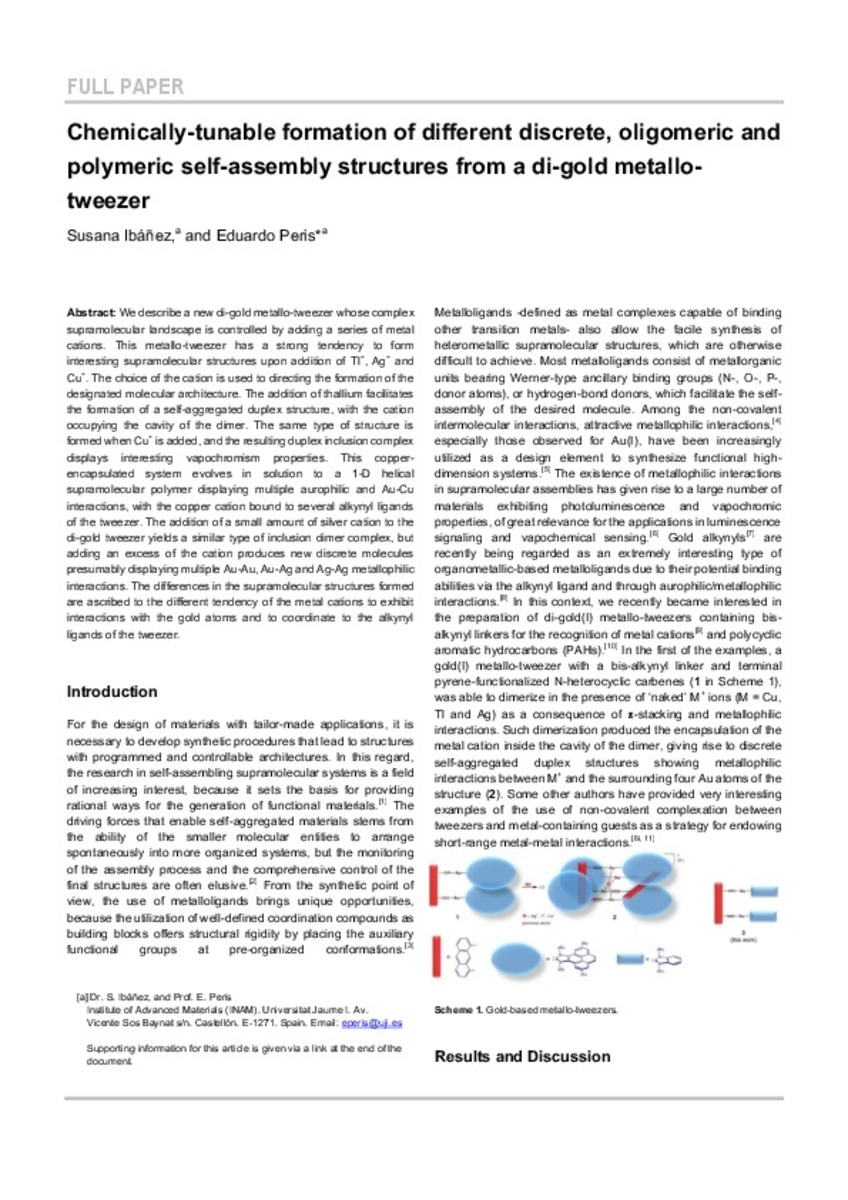Mostrar el registro sencillo del ítem
Chemically Tunable Formation of Different Discrete, Oligomeric, and Polymeric Self‐Assembled Structures from Digold Metallotweezers
| dc.contributor.author | Ibáñez, Susana | |
| dc.contributor.author | Peris, Eduardo | |
| dc.date.accessioned | 2018-09-18T07:55:09Z | |
| dc.date.available | 2018-09-18T07:55:09Z | |
| dc.date.issued | 2018 | |
| dc.identifier.citation | IBÁÑEZ, Susana; PERIS, Eduardo. Chemically Tunable Formation of Different Discrete, Oligomeric, and Polymeric Self‐Assembled Structures from Digold Metallotweezers. Chemistry–A European Journal, 2018, vol. 24, no 33, p. 8424-8431 | ca_CA |
| dc.identifier.issn | 0947-6539 | |
| dc.identifier.issn | 1521-3765 | |
| dc.identifier.uri | http://hdl.handle.net/10234/176107 | |
| dc.description.abstract | Digold metallotweezers whose complex supramolecular landscape is controlled by adding a series of metal cations are described. The metallotweezers have a strong tendency to form interesting supramolecular structures on addition of Tl+, Ag+, and Cu+. The choice of the cation can be used to direct the formation of a designated molecular architecture. The addition of thallium facilitates the formation of a self‐aggregated duplex structure in which the cation occupies the cavity of the dimer. The same type of structure is formed when Cu+ is added, and the resulting duplex inclusion complex shows interesting vapochromic properties. This copper‐encapsulating system evolves in solution to a 1D helical supramolecular polymer showing multiple aurophilic and Au⋅⋅⋅Cu interactions, in which the copper cation is bound to several alkynyl ligands of the tweezer. The addition of a small amount of silver cations to the digold tweezer yields a similar type of inclusion dimer complex, but adding an excess of the cation produces new discrete molecules presumably exhibiting multiple Au⋅⋅⋅Au, Au⋅⋅⋅Ag, and Ag⋅⋅⋅Ag metallophilic interactions. The differences in the supramolecular structures formed are ascribed to the different tendencies of the metal cations to exhibit interactions with the gold atoms and to coordinate to the alkynyl ligands of the tweezer. | ca_CA |
| dc.format.extent | 8 p. | ca_CA |
| dc.format.mimetype | application/pdf | ca_CA |
| dc.language.iso | eng | ca_CA |
| dc.relation.isPartOf | Chemistry–A European Journal, 2018, vol. 24, no 33 | ca_CA |
| dc.rights | Copyright © John Wiley & Sons, Inc. | ca_CA |
| dc.rights.uri | http://rightsstatements.org/vocab/InC/1.0/ | * |
| dc.subject | gold | ca_CA |
| dc.subject | metal-metal interactions | ca_CA |
| dc.subject | self-assembly | ca_CA |
| dc.subject | supramolecular chemistry | ca_CA |
| dc.subject | vapochromism | ca_CA |
| dc.title | Chemically Tunable Formation of Different Discrete, Oligomeric, and Polymeric Self‐Assembled Structures from Digold Metallotweezers | ca_CA |
| dc.type | info:eu-repo/semantics/article | ca_CA |
| dc.identifier.doi | https://doi.org/10.1002/chem.201801134 | |
| dc.relation.projectID | MINECO of Spain / CTQ2014-51999-P; Universitat Jaume I / UJI-B2017-07; UJI-A2017-02 | ca_CA |
| dc.rights.accessRights | info:eu-repo/semantics/openAccess | ca_CA |
| dc.relation.publisherVersion | https://onlinelibrary.wiley.com/doi/full/10.1002/chem.201801134 | ca_CA |
| dc.date.embargoEndDate | 2019-03-30 | |
| dc.contributor.funder | We are grateful to the Serveis Centrals d'Instrumentacio Cientifica (SCIC-UJI) for providing with spectroscopic facilities. We also want to thank Dr. Macarena Poyatos for resolving the X-ray diffraction structures and for her valuable contributions to the improvement of the studies presented in this manuscript. | ca_CA |
| dc.type.version | info:eu-repo/semantics/acceptedVersion | ca_CA |
Ficheros en el ítem
Este ítem aparece en la(s) siguiente(s) colección(ones)
-
INAM_Articles [506]







